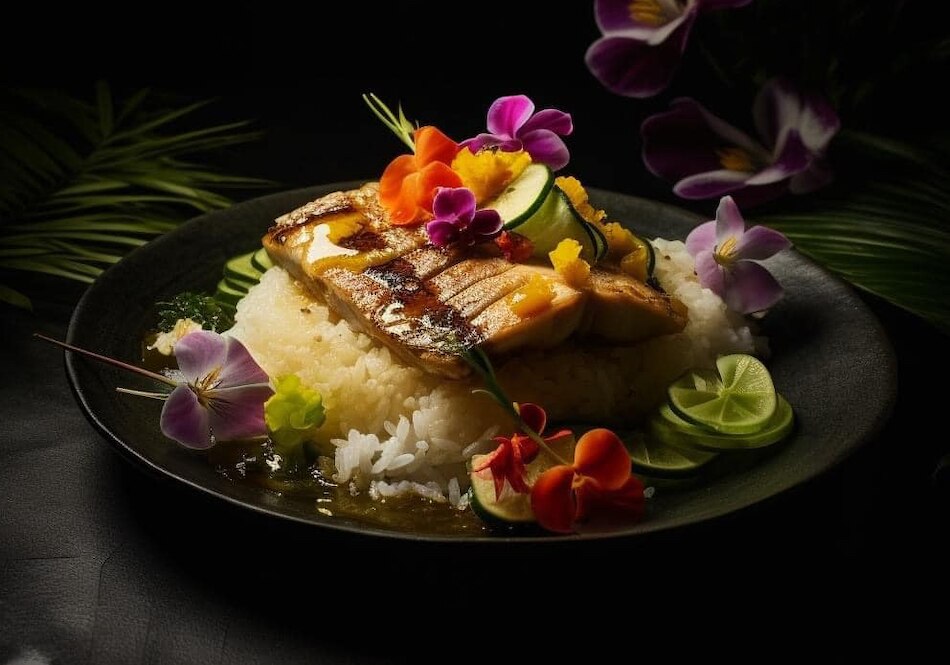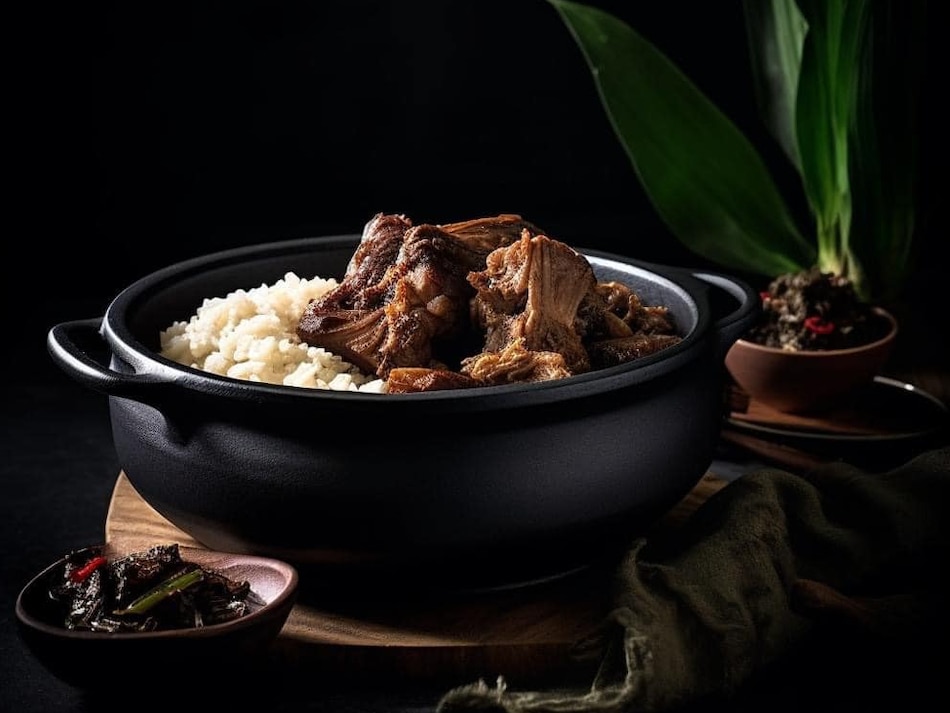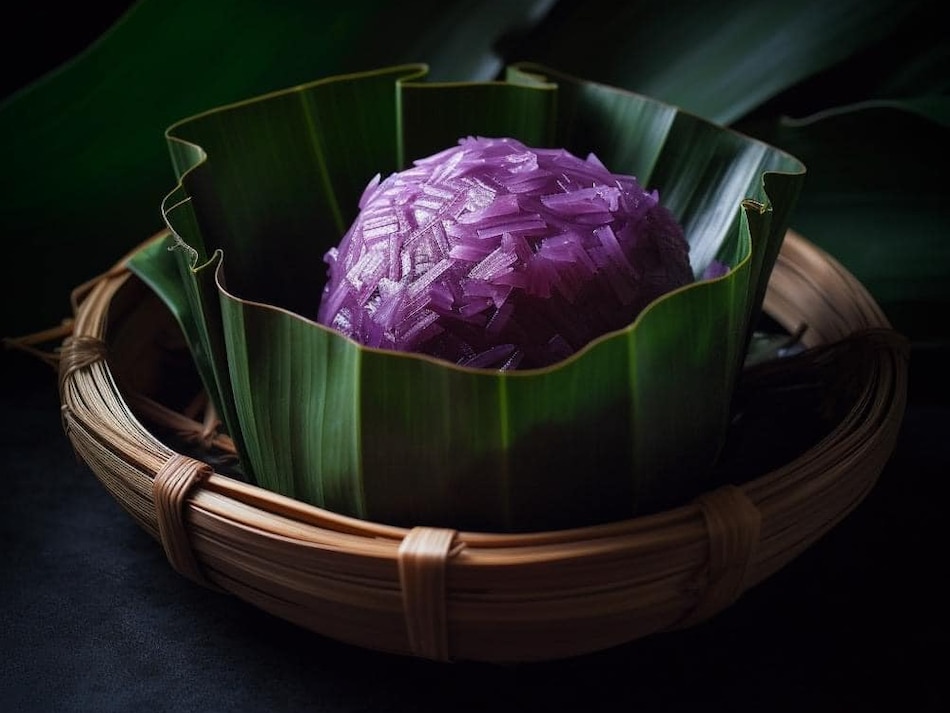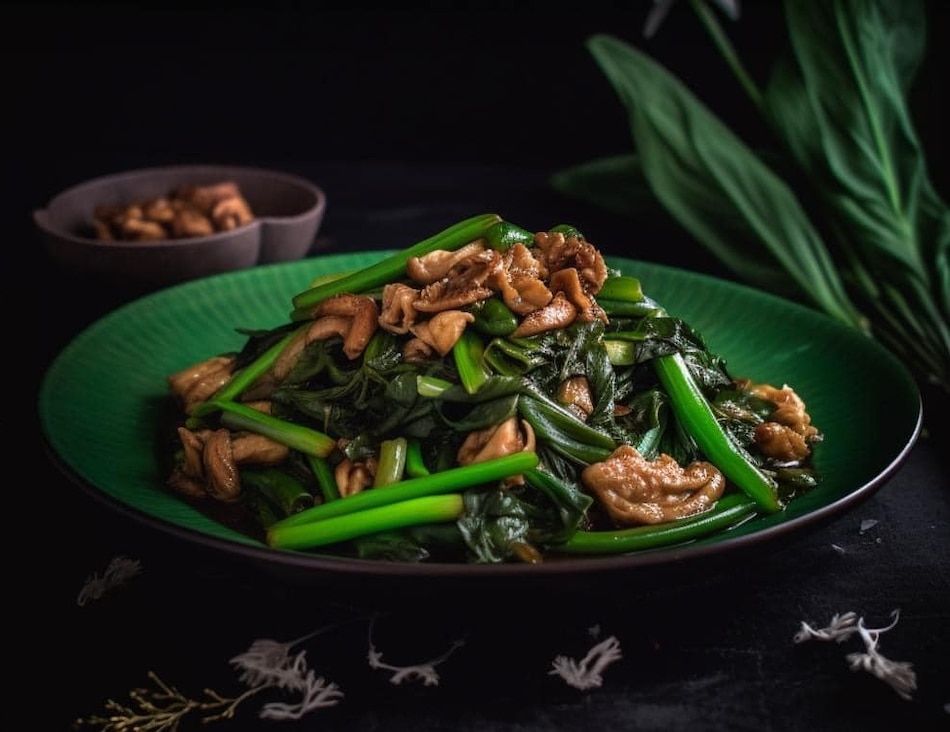Kinilamok na Baboy, Binalugang Dalag, Kesong-Biya—are these Pinoy-sounding dishes for real? | ABS-CBN

Welcome, Kapamilya! We use cookies to improve your browsing experience. Continuing to use this site means you agree to our use of cookies. Tell me more!
Kinilamok na Baboy, Binalugang Dalag, Kesong-Biya—are these Pinoy-sounding dishes for real?
Kinilamok na Baboy, Binalugang Dalag, Kesong-Biya—are these Pinoy-sounding dishes for real?
ANCX Staff
Published Apr 25, 2023 12:03 PM PHT
|
Updated Apr 25, 2023 12:22 PM PHT
At first glance, some of the food images on Filipino virtual reality developer Cristopher “Toph” David’s Facebook page look real. Reading the description of one beautifully plated dish, it sounds like a fresh, tasty gata recipe: “Tinikim na Manok—a flavorful chicken dish cooked in a sauce made from calamansi, ginger, and coconut milk, garnished with toasted coconut flakes and chopped cilantro, served with a side of steamed rice.”
At first glance, some of the food images on Filipino virtual reality developer Cristopher “Toph” David’s Facebook page look real. Reading the description of one beautifully plated dish, it sounds like a fresh, tasty gata recipe: “Tinikim na Manok—a flavorful chicken dish cooked in a sauce made from calamansi, ginger, and coconut milk, garnished with toasted coconut flakes and chopped cilantro, served with a side of steamed rice.”
Another dish, “Balaw Sapal,” seems like a hearty soup you’d like to have at any given day—it’s “made from young bamboo shoots, corn, and coconut milk, topped with chunks of native chicken, and garnished with alugbati (malabar spinach leaves).”
Another dish, “Balaw Sapal,” seems like a hearty soup you’d like to have at any given day—it’s “made from young bamboo shoots, corn, and coconut milk, topped with chunks of native chicken, and garnished with alugbati (malabar spinach leaves).”
There’s one that sounds a little strange: the “Kesong-Biya” (isn’t biya a fish?)—but the image and descriptions are mouthwatering. It’s “a dessert featuring layers of creamy carabao milk cheese, crispy flour wafers, and sweetened mangosteen jam, served chilled with a drizzle of coconut caramel sauce.”
There’s one that sounds a little strange: the “Kesong-Biya” (isn’t biya a fish?)—but the image and descriptions are mouthwatering. It’s “a dessert featuring layers of creamy carabao milk cheese, crispy flour wafers, and sweetened mangosteen jam, served chilled with a drizzle of coconut caramel sauce.”
The name “Kinilamok na Baboy” might make you want to grab a mosquito repellant, but it’s possibly a unique take on Mexico’s national dish “mole poblano.” It’s “slow-cooked pork shoulder in a rich broth of star anise, lemongrass, and native chocolate, served with a side of steamed malunggay rice and atchara.”
The name “Kinilamok na Baboy” might make you want to grab a mosquito repellant, but it’s possibly a unique take on Mexico’s national dish “mole poblano.” It’s “slow-cooked pork shoulder in a rich broth of star anise, lemongrass, and native chocolate, served with a side of steamed malunggay rice and atchara.”
ADVERTISEMENT
The dishes don’t sound like they’re time-honored Filipino fare. They’ve existed only in Toph David’s imagination and now as images created thru artificial intelligence apps Chat GPT-4, or Generative Pre-trained Transformer 4, and Midjourney. Toph has been exploring the said programs to increase his work productivity and also to produce cooking content for his TikTok account @tophoftheworld.
The dishes don’t sound like they’re time-honored Filipino fare. They’ve existed only in Toph David’s imagination and now as images created thru artificial intelligence apps Chat GPT-4, or Generative Pre-trained Transformer 4, and Midjourney. Toph has been exploring the said programs to increase his work productivity and also to produce cooking content for his TikTok account @tophoftheworld.
He was enticed to try GPT-4 after finding out its many advancements compared to GPT-3. With the previous model, he asked for variations of existing Filipino dishes—and GPT-3 suggested dishes like Mango Adobo, Sinigang na Baboy sa Mangga, Pinakbet Pizza, and Bicol Express Burrito. “With the new version, I was able to create totally new recipes,” Toph says. “It can generate a lot of creative prompts. I was able to create something from scratch.” The images look both realistic and alluring, too, thanks to Midjourney.
He was enticed to try GPT-4 after finding out its many advancements compared to GPT-3. With the previous model, he asked for variations of existing Filipino dishes—and GPT-3 suggested dishes like Mango Adobo, Sinigang na Baboy sa Mangga, Pinakbet Pizza, and Bicol Express Burrito. “With the new version, I was able to create totally new recipes,” Toph says. “It can generate a lot of creative prompts. I was able to create something from scratch.” The images look both realistic and alluring, too, thanks to Midjourney.
If the names of the dishes sound like you’ve never heard them before, it’s because what Toph asked GPT-4 to do was create imaginary Filipino dishes using local ingredients and cooking techniques. He also asked the artificial intelligence program to pattern the food’s names after existing Filipino dishes, using words that are not necessarily in the Filipino vocabulary or don’t really mean anything. This explains the dishes like Talukab Gisa, Balaw Sapal, Manok Balistis, Kinilamok na Baboy, Binalugang Dalag (which might raise eyebrows), Bukid Batala, Tamalimang Manok, and Payanga.
If the names of the dishes sound like you’ve never heard them before, it’s because what Toph asked GPT-4 to do was create imaginary Filipino dishes using local ingredients and cooking techniques. He also asked the artificial intelligence program to pattern the food’s names after existing Filipino dishes, using words that are not necessarily in the Filipino vocabulary or don’t really mean anything. This explains the dishes like Talukab Gisa, Balaw Sapal, Manok Balistis, Kinilamok na Baboy, Binalugang Dalag (which might raise eyebrows), Bukid Batala, Tamalimang Manok, and Payanga.
A self-confessed foodie, Toph says he also added his own creative contributions to the dishes to make them more interesting. The virtual reality developer says he plans to recreate the dishes and post them on his TikTok and Instagram accounts. In fact, he already created one from GPT-3’s suggestions, the Mango Adobo. “It surprisingly tastes good!” he says. So he expects the dishes from GPT-4 to taste even better.
A self-confessed foodie, Toph says he also added his own creative contributions to the dishes to make them more interesting. The virtual reality developer says he plans to recreate the dishes and post them on his TikTok and Instagram accounts. In fact, he already created one from GPT-3’s suggestions, the Mango Adobo. “It surprisingly tastes good!” he says. So he expects the dishes from GPT-4 to taste even better.
Images courtesy of Cristopher David
ADVERTISEMENT
ADVERTISEMENT






